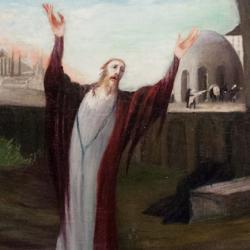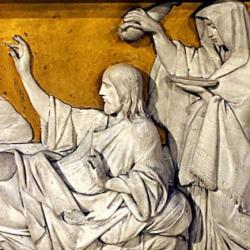INTRODUCTION
Matthew’s gospel is organized to show that Jesus is the True Israel, reliving Israel’s history faithfully. But Matthew also shows that Jesus is Israel’s God, who is rejected by His own people but triumphs over their rejection.
THE TEXT
“The book of the genealogy of Jesus Christ, the Son of David, the Son of Abraham.” “And Jesus came and spoke to them, saying, ‘All authority has been given to Me in heaven and on earth. Go therefore and make disciples of all the nations, baptizing them in the name of the Father and of the Son and of the Holy Spirit, teaching them to observe all things that I have commanded you; and lo, I am with you always, even to the end of the age . . . .’” (Matthew 1:1; 28:18-20).
BEGINNING AND END
Matthew begins his gospel with a genealogy of Jesus. He introduces that genealogy with a phrase that alludes to a phrase found ten times in the Greek translation of the book of Genesis (cf. Genesis 5:1). Matthew is telling us that the story of Jesus is a new beginning in history. He finishes the book with the Great Commission (28:18-20), which in form and content is reminiscent of the decree of Cyrus (2 Chronicles 36:22-23). As we have it today, the Hebrew Bible ends with the book of Chronicles. Matthew may be indicating that the story of Jesus covers the entire canon of the Old Testament. Jesus lives the history of Israel from creation to restoration from exile.
MIDDLE
Matthew’s gospel differs from the other gospels in the fact that it is organized by five large discourses: The Sermon on the Mount (Matthew 5-7), instructions for mission (Matthew 10), parables of the kingdom (Matthew 13), instructions about forgiveness and discipline (Matthew 18), and the Olivet Discourse (Matthew 23-25). If Matthew is showing Jesus reliving the history of Israel, it would make sense if these discourses matched different periods of that history.
They do seem to do that: The Sermon on the Mount is a recapitulation of Sinai; Jesus’ instructions to the Twelve remind us of Moses’ instructions for conquest in Deuteronomy; the parables of the kingdom are a form of wisdom literature, associated with Solomon; the chapter on forgiveness and discipline teach the disciples how to live as a new Israel within the old, similar to the prophetic communities in the time of Elijah and Elisha; in the Olivet Discourse, Jesus is announcing the destruction of the temple, like a new Jeremiah. In his death and resurrection, Jesus relives Israel’s exile and return.
ISRAEL’S GOD
Jesus is not only Israel. He is Israel and Israel’s God in one person. God came to Israel in Moses, and was rejected. God came to Israel through kings and prophets, yet Israel refused to listen to her Lord. This is also the story of Jesus, as the parable of the vineyard makes clear (Matthew 21:33-46). Yet, the God of Israel does not allow Israel’s rejection to be the final word. When Israel has done her worst, and executed Yahweh incarnate, God raises Jesus from the dead. And so all Israel shall be saved.















